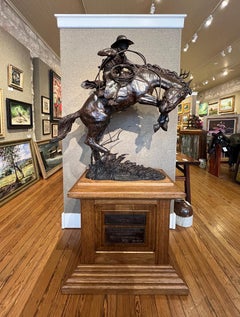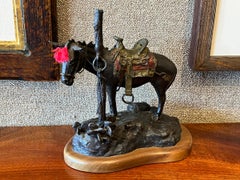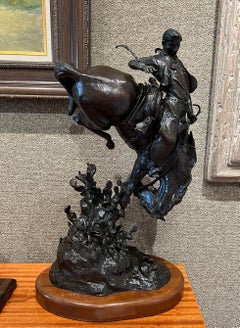G. Harvey Figurative Sculptures
Gerald Harvey Jones was born in San Antonio, Texas, in 1933. His grandfather was a cowboy during the trail-driving era when legends grew up along the dusty trails north from Texas. Family stories of wild cattle and tough men were absorbed by Harvey and became the genesis of his art. Known for paintings closely linked in mood and subject matter to Edouard Cortes, G Harvey created romanticized street scenes of the turn of the century towns in America. Rain slick streets reflect urban lights, and the weather, which was obviously cold. Harvey's early interest in sketching and drawing slowly evolved into a passion for painting in oils. After graduating cum laude from North Texas State University, Harvey took a position with the University of Texas in Austin, but he soon realized that weekends and nights at the easel did not satisfy his love of painting. He abandoned the security of a full-time job in 1963 and threw his total energy into a fine art career. It was through painting that he found his greatest satisfaction, and his native central Texas hill country provided the inspiration for most of his earlier work. He sought the essence that is Texas and found it not only along the banks of the Guadalupe, but in cow camps west of the Pecos, and in the shadows of tall buildings in big Texas cities and the streets of Dallas, which once echoed with the sound of horses hooves and the jingle of spurs. Historic photographs reveal what it looked like, but artists like Harvey can enable a viewer to experience the mood and flavor or the time. In his paintings, the viewer only sees the physical elements of his subject but also senses the mood that surrounds them. It is a remarkable aspect of fine art, which few artists are able to master.
Harvey painted the spirit of America from its western hills and prairies to the commerce of its great cities. His original paintings and bronze sculptures are in the collections of major corporations, prestigious museums, the United States government, American presidents, governors, foreign leaders and captains of industry. The Smithsonian Institution chose Harvey to paint The Smithsonian Dream, commemorating its 150th Anniversary. The Christmas Pageant of Peace commissioned Harvey to create a painting celebrating this national event. He has been the recipient of many awards and the subject of three books. Harvey was a soft-spoken and unassuming man who cared deeply about what he painted without becoming maudlin or melodramatic. Before his death, Harvey lived in Fredericksburg, Texas, with his wife Pat in a 150-year old stone home built by German settlers. His studio and residence were nestled within the Historic District of Fredericksburg.
Early 2000s Impressionist G. Harvey Figurative Sculptures
Bronze
Late 20th Century Impressionist G. Harvey Figurative Sculptures
Bronze
1980s Impressionist G. Harvey Figurative Sculptures
Bronze
1980s Impressionist G. Harvey Figurative Sculptures
Bronze
Early 2000s American Impressionist G. Harvey Figurative Sculptures
Bronze
2010s Impressionist G. Harvey Figurative Sculptures
Bronze
Early 2000s American Impressionist G. Harvey Figurative Sculptures
Plastic, Sailcloth, Chalk, Fabric, Wood, Oil, Mixed Media, Paper
1870s Impressionist G. Harvey Figurative Sculptures
Bronze
2010s Impressionist G. Harvey Figurative Sculptures
Sandstone, Bronze
2010s Impressionist G. Harvey Figurative Sculptures
Bronze
2010s Impressionist G. Harvey Figurative Sculptures
Sandstone, Bronze
1910s American Impressionist G. Harvey Figurative Sculptures
Bronze
Early 20th Century Impressionist G. Harvey Figurative Sculptures
Bronze
2010s Impressionist G. Harvey Figurative Sculptures
Bronze
2010s Impressionist G. Harvey Figurative Sculptures
Bronze
Early 2000s American Impressionist G. Harvey Figurative Sculptures
Bronze
1980s Impressionist G. Harvey Figurative Sculptures
Bronze
Early 2000s Impressionist G. Harvey Figurative Sculptures
Bronze
1980s Impressionist G. Harvey Figurative Sculptures
Bronze
1980s Impressionist G. Harvey Figurative Sculptures
Bronze
G. Harvey figurative sculptures for sale on 1stDibs.
- Who is G. Harvey the artist?1 Answer1stDibs ExpertMarch 22, 2022The artist G. Harvey was a painter and sculptor who lived from 1933 to 2017. His work fits into the American Traditionalist movement and is largely focused on landscapes and cityscapes. Margaret Thatcher and Lyndon B. Johnson were avid collectors of his work. On 1stDibs, find a range of G. Harvey art.






